ECU Hyundai Equus 2016 Owner's Manual
[x] Cancel search | Manufacturer: HYUNDAI, Model Year: 2016, Model line: Equus, Model: Hyundai Equus 2016Pages: 477, PDF Size: 16.25 MB
Page 8 of 477
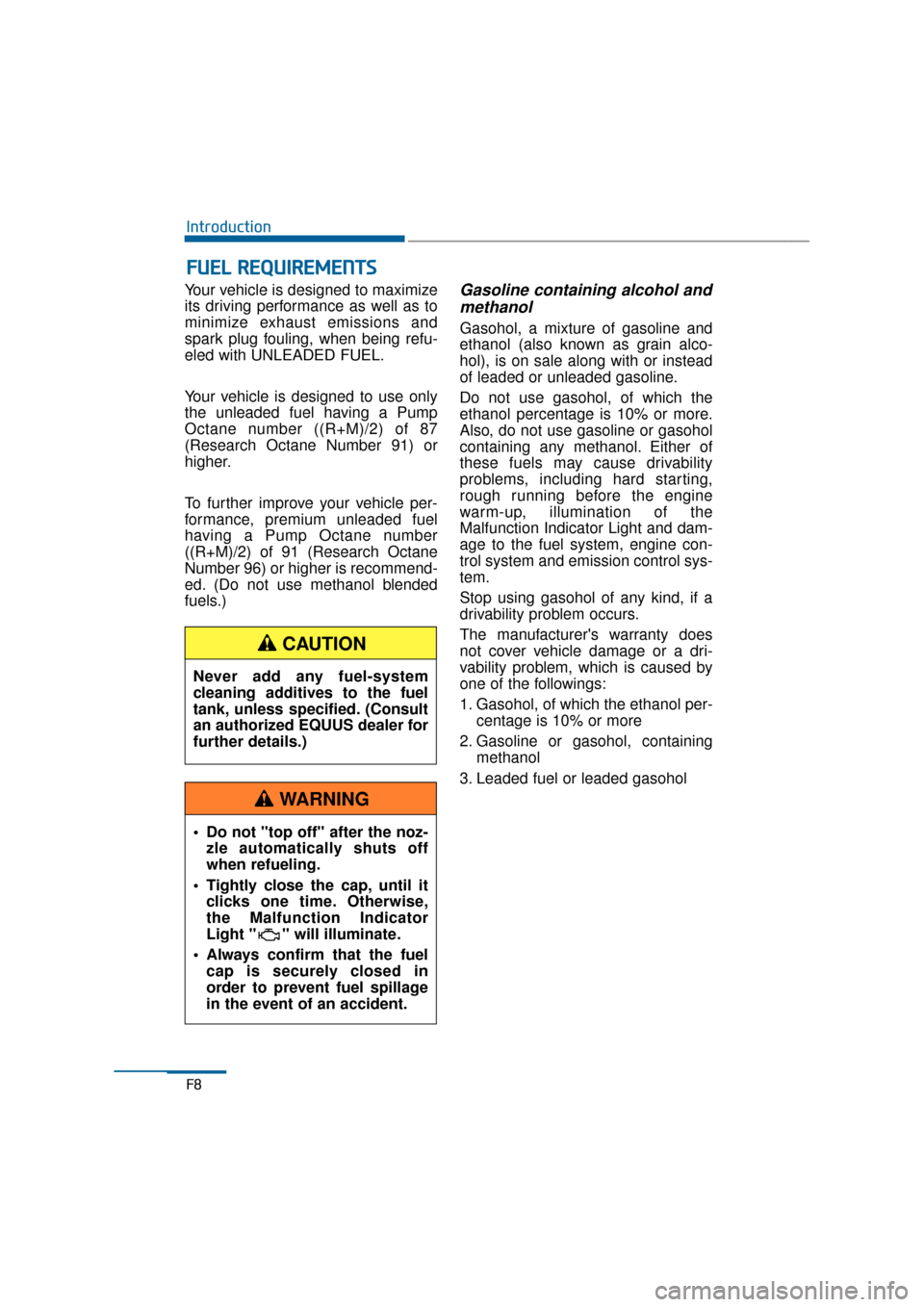
Your vehicle is designed to maximize
its driving performance as well as to
minimize exhaust emissions and
spark plug fouling, when being refu-
eled with UNLEADED FUEL.
Your vehicle is designed to use only
the unleaded fuel having a Pump
Octane number ((R+M)/2) of 87
(Research Octane Number 91) or
higher.
To further improve your vehicle per-
formance, premium unleaded fuel
having a Pump Octane number
((R+M)/2) of 91 (Research Octane
Number 96) or higher is recommend-
ed. (Do not use methanol blended
fuels.)Gasoline containing alcohol andmethanol
Gasohol, a mixture of gasoline and
ethanol (also known as grain alco-
hol), is on sale along with or instead
of leaded or unleaded gasoline.
Do not use gasohol, of which the
ethanol percentage is 10% or more.
Also, do not use gasoline or gasohol
containing any methanol. Either of
these fuels may cause drivability
problems, including hard starting,
rough running before the engine
warm-up, illumination of the
Malfunction Indicator Light and dam-
age to the fuel system, engine con-
trol system and emission control sys-
tem.
Stop using gasohol of any kind, if a
drivability problem occurs.
The manufacturer's warranty does
not cover vehicle damage or a dri-
vability problem, which is caused by
one of the followings:
1. Gasohol, of which the ethanol per-
centage is 10% or more
2. Gasoline or gasohol, containing methanol
3. Leaded fuel or leaded gasohol
F F U
U E
EL
L
R
R E
EQ
Q U
UI
IR
R E
EM
M E
EN
N T
TS
S
Introduction
F8
Do not "top off" after the noz-
zle automatically shuts off
when refueling.
Tightly close the cap, until it clicks one time. Otherwise,
the Malfunction Indicator
Light " " will illuminate.
Always confirm that the fuel cap is securely closed in
order to prevent fuel spillage
in the event of an accident.
WARNING
Never add any fuel-system
cleaning additives to the fuel
tank, unless specified. (Consult
an authorized EQUUS dealer for
further details.)
CAUTION
Page 35 of 477
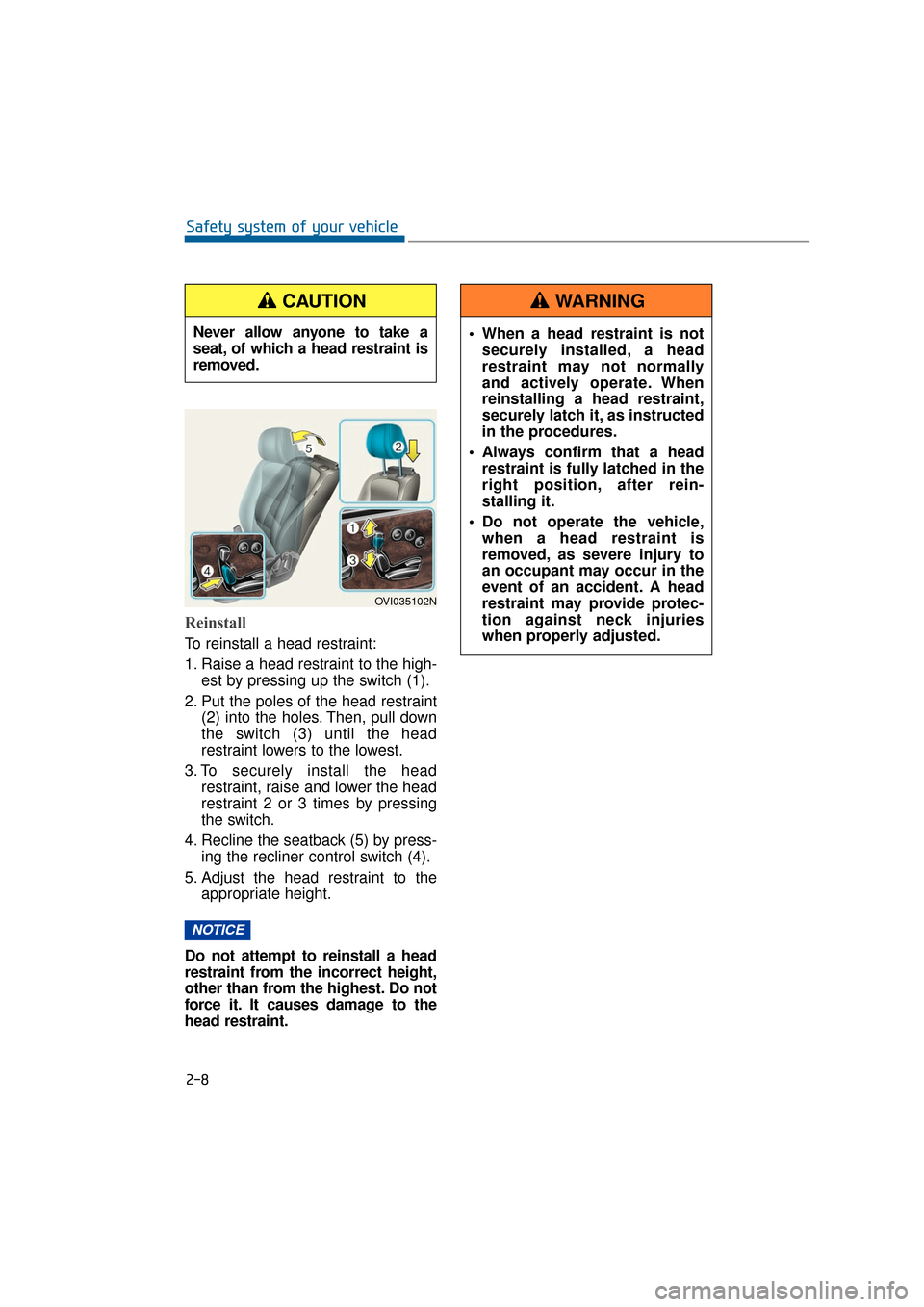
Reinstall
To reinstall a head restraint:
1. Raise a head restraint to the high-est by pressing up the switch (1).
2. Put the poles of the head restraint (2) into the holes. Then, pull down
the switch (3) until the head
restraint lowers to the lowest.
3. To securely install the head restraint, raise and lower the head
restraint 2 or 3 times by pressing
the switch.
4. Recline the seatback (5) by press- ing the recliner control switch (4).
5. Adjust the head restraint to the appropriate height.
Do not attempt to reinstall a head
restraint from the incorrect height,
other than from the highest. Do not
force it. It causes damage to the
head restraint.
NOTICE
2-8
Safety system of your vehicle
OVI035102N
When a head restraint is not securely installed, a head
restraint may not normally
and actively operate. When
reinstalling a head restraint,
securely latch it, as instructed
in the procedures.
Always confirm that a head restraint is fully latched in the
right position, after rein-
stalling it.
Do not operate the vehicle, when a head restraint is
removed, as severe injury to
an occupant may occur in the
event of an accident. A head
restraint may provide protec-
tion against neck injuries
when properly adjusted.
WARNING
Never allow anyone to take a
seat, of which a head restraint is
removed.
CAUTION
Page 49 of 477
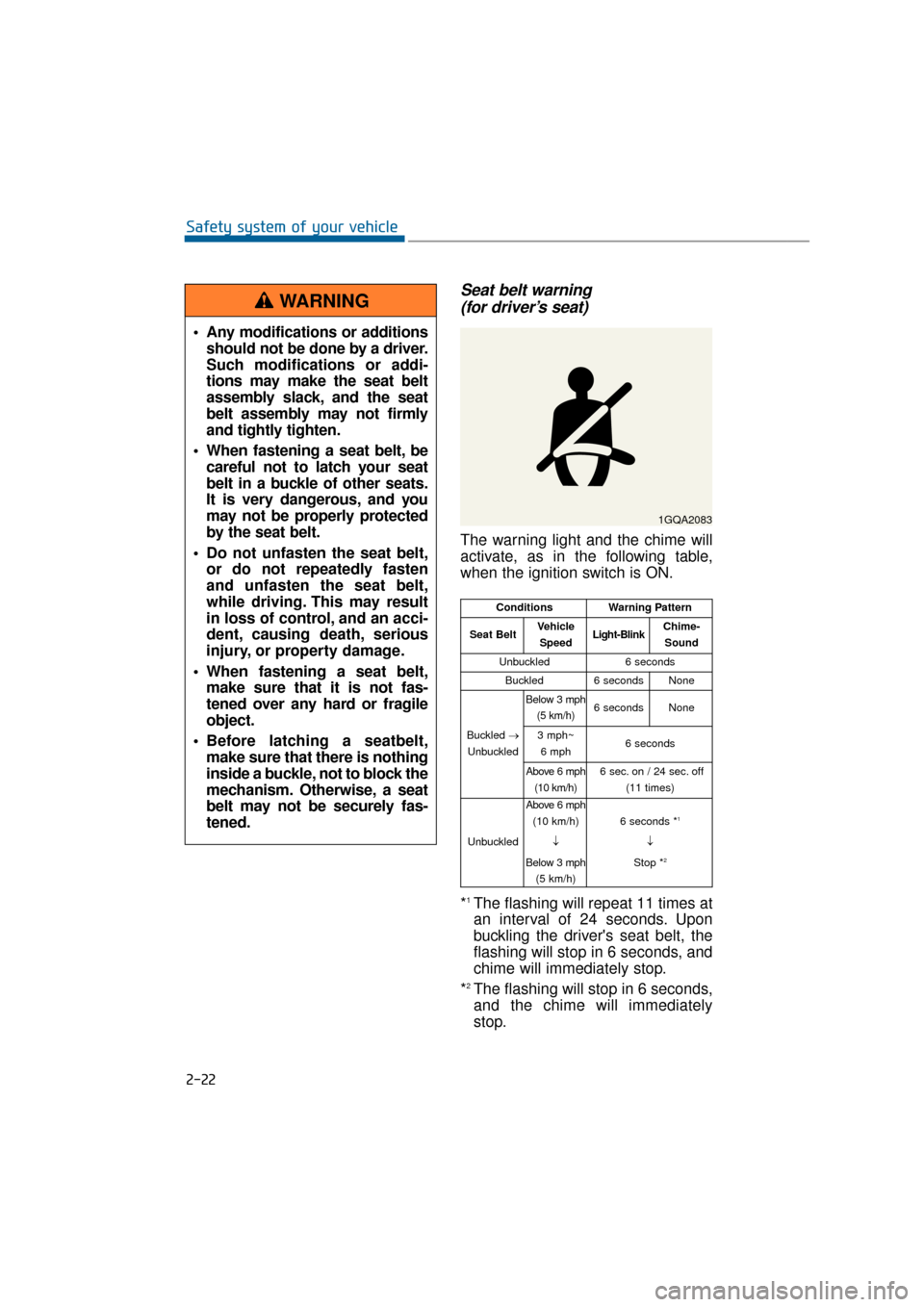
Seat belt warning (for driver’s seat)
The warning light and the chime will
activate, as in the following table,
when the ignition switch is ON.
*
1The flashing will repeat 11 times at
an interval of 24 seconds. Upon
buckling the driver's seat belt, the
flashing will stop in 6 seconds, and
chime will immediately stop.
*
2The flashing will stop in 6 seconds,
and the chime will immediately
stop.
2-22
Safety system of your vehicle
Any modifications or additions should not be done by a driver.
Such modifications or addi-
tions may make the seat belt
assembly slack, and the seat
belt assembly may not firmly
and tightly tighten.
When fastening a seat belt, be careful not to latch your seat
belt in a buckle of other seats.
It is very dangerous, and you
may not be properly protected
by the seat belt.
Do not unfasten the seat belt, or do not repeatedly fasten
and unfasten the seat belt,
while driving. This may result
in loss of control, and an acci-
dent, causing death, serious
injury, or property damage.
When fastening a seat belt, make sure that it is not fas-
tened over any hard or fragile
object.
Before latching a seatbelt, make sure that there is nothing
inside a buckle, not to block the
mechanism. Otherwise, a seat
belt may not be securely fas-
tened.
WARNING
1GQA2083
ConditionsWarning Pattern
Seat BeltVehicle
SpeedLight-BlinkChime-Sound
Unbuckled6 seconds
Buckled6 secondsNone
Buckled →
Unbuckled
Below 3 mph (5 km/h)6 secondsNone
3 mph~6 mph6 seconds
Above 6 mph (10 km/h)6 sec. on / 24 sec. off (11 times)
Unbuckled
Above 6 mph(10 km/h)
↓
Below 3 mph (5 km/h)
6 seconds *1
↓
Stop *
2
Page 51 of 477

Height adjustment
The anchor height for the shoulder
portion of the belt can be adjusted to
one of the 4 positions for your greatest
comfort and safety.
The anchor height should be adjusted,
so the shoulder portion is fastened
over your chest and midway over the
shoulder nearest the door, not over
your neck.
To adjust the anchor height, rise up or
lower down the adjuster.
To rise up the adjuster, pull it up (1). To
lower it down, push it down (3) while
pressing the height adjuster button (2).
Release the button to lock the anchor
height. Attempt to slide up or down the
adjuster to confirm its locking.
2-24
Safety system of your vehicle
OVI035109N
Front seat
Make sure that the shoulderbelt anchor is securely locked
at an appropriate height.
Never fasten the shoulder
portion of the belt over your
neck or face. Improper fasten-
ing may cause serious injury
in an accident.
(Continued)
WARNING
(Continued)
Failure to replace a seat beltassembly after an accident
may put you in danger,
because the damaged seat
belt will not provide protec-
tion in the event of another
collision, leading to personal
injury or death. Immediately
replace your seat belts after
an accident.
The lap portion of a seat belt
should be fastened as low as
possible and snugly across your
hips, not on your waist. When
the lap belt is fastened too high
on your waist, it may increase
injury risk in the event of a colli-
sion. Both arms should not be
under or over the belt. Rather,
one should be over and the
other under, as shown in the
illustration.
The seat belt should not be fas-
tened under the driver's left arm,
or the front passenger's right
arm.
WARNING
OVI035110N
Page 57 of 477
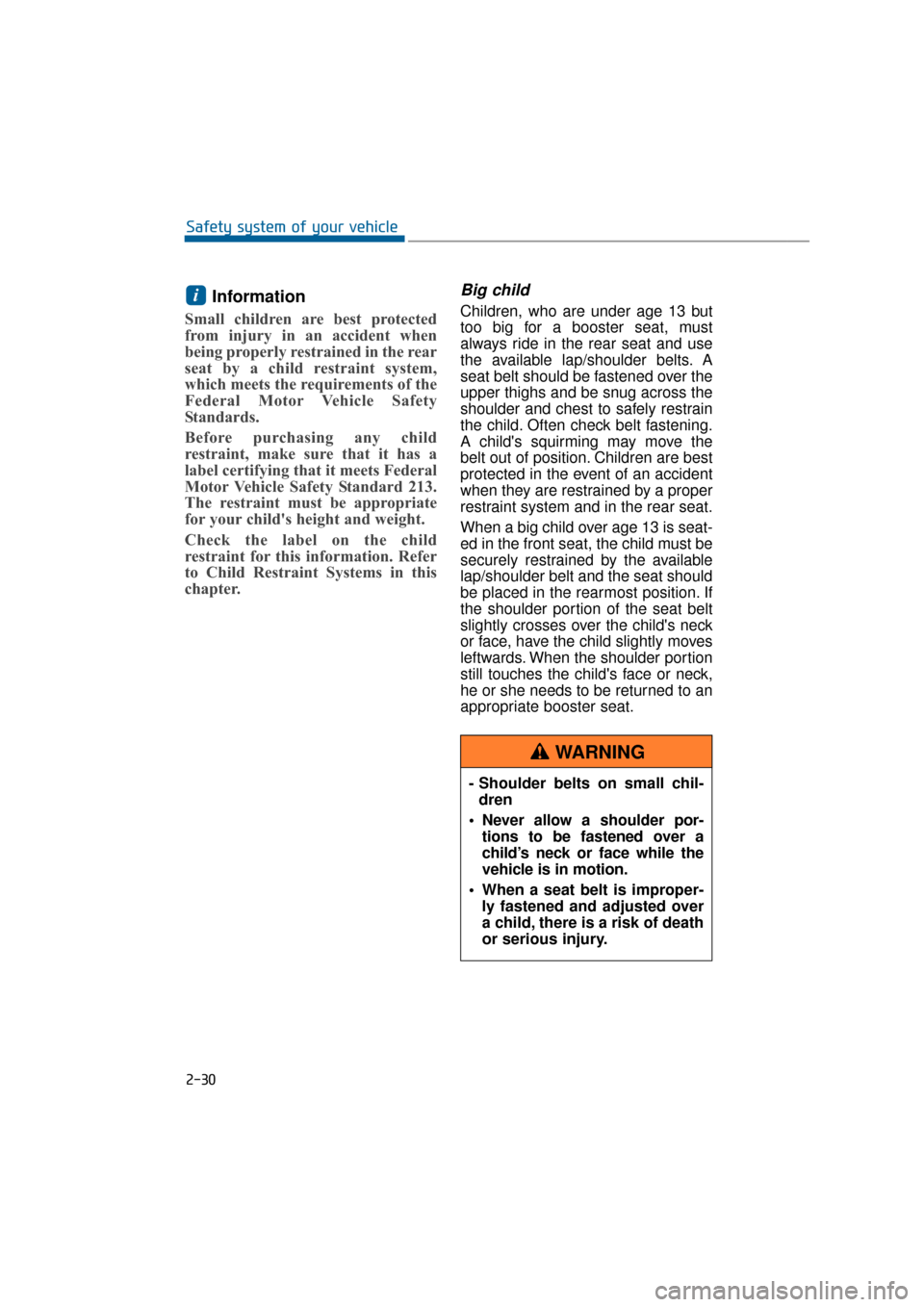
2-30
Safety system of your vehicle
Information
Small children are best protected
from injury in an accident when
being properly restrained in the rear
seat by a child restraint system,
which meets the requirements of the
Federal Motor Vehicle Safety
Standards.
Before purchasing any child
restraint, make sure that it has a
label certifying that it meets Federal
Motor Vehicle Safety Standard 213.
The restraint must be appropriate
for your child's height and weight.
Check the label on the child
restraint for this information. Refer
to Child Restraint Systems in this
chapter.
Big child
Children, who are under age 13 but
too big for a booster seat, must
always ride in the rear seat and use
the available lap/shoulder belts. A
seat belt should be fastened over the
upper thighs and be snug across the
shoulder and chest to safely restrain
the child. Often check belt fastening.
A child's squirming may move the
belt out of position. Children are best
protected in the event of an accident
when they are restrained by a proper
restraint system and in the rear seat.
When a big child over age 13 is seat-
ed in the front seat, the child must be
securely restrained by the available
lap/shoulder belt and the seat should
be placed in the rearmost position. If
the shoulder portion of the seat belt
slightly crosses over the child's neck
or face, have the child slightly moves
leftwards. When the shoulder portion
still touches the child's face or neck,
he or she needs to be returned to an
appropriate booster seat.i
- Shoulder belts on small chil-dren
Never allow a shoulder por- tions to be fastened over a
child’s neck or face while the
vehicle is in motion.
When a seat belt is improper- ly fastened and adjusted over
a child, there is a risk of death
or serious injury.
WARNING
Page 60 of 477
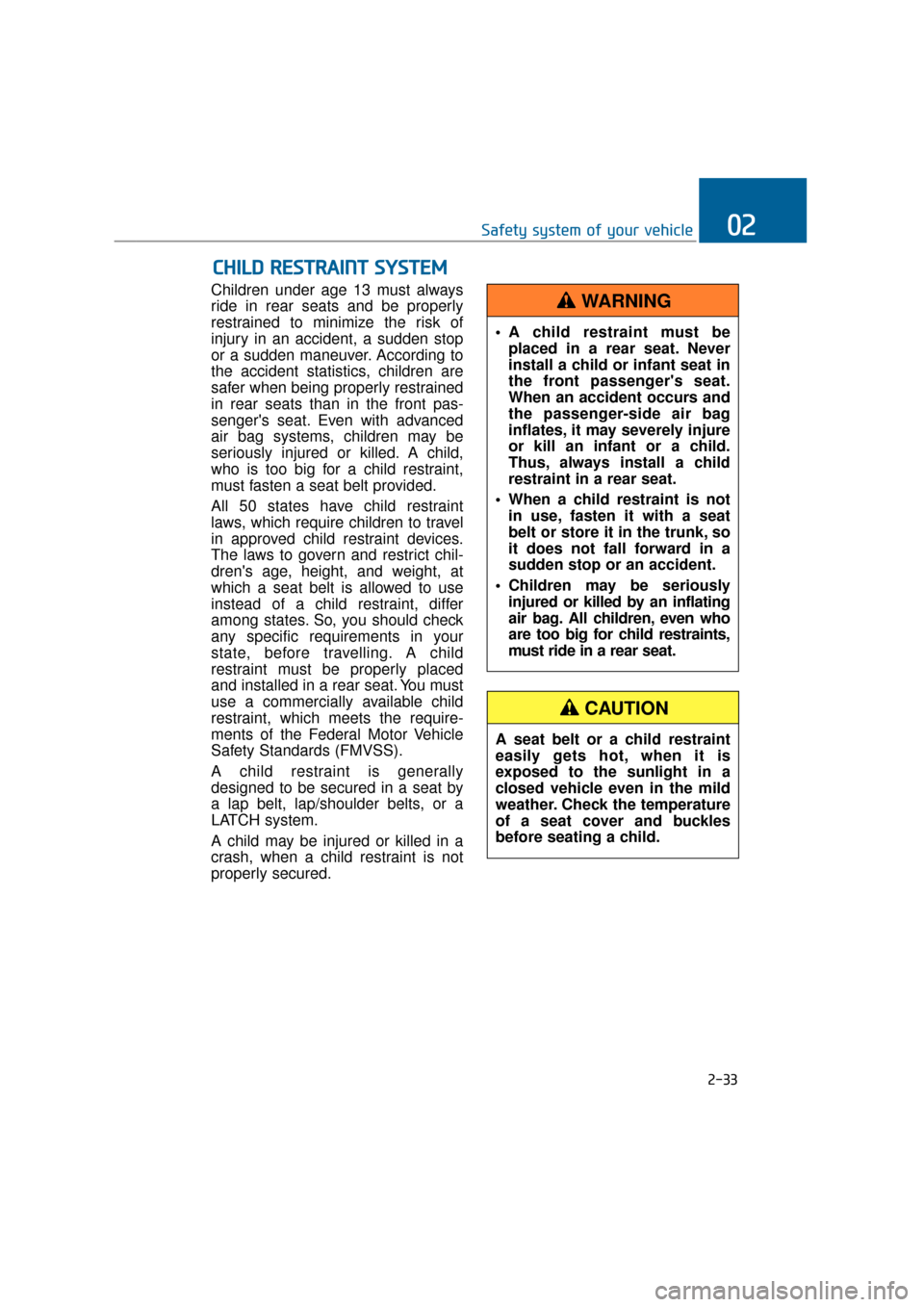
Children under age 13 must always
ride in rear seats and be properly
restrained to minimize the risk of
injury in an accident, a sudden stop
or a sudden maneuver. According to
the accident statistics, children are
safer when being properly restrained
in rear seats than in the front pas-
senger's seat. Even with advanced
air bag systems, children may be
seriously injured or killed. A child,
who is too big for a child restraint,
must fasten a seat belt provided.
All 50 states have child restraint
laws, which require children to travel
in approved child restraint devices.
The laws to govern and restrict chil-
dren's age, height, and weight, at
which a seat belt is allowed to use
instead of a child restraint, differ
among states. So, you should check
any specific requirements in your
state, before travelling. A child
restraint must be properly placed
and installed in a rear seat. You must
use a commercially available child
restraint, which meets the require-
ments of the Federal Motor Vehicle
Safety Standards (FMVSS).
A child restraint is generally
designed to be secured in a seat by
a lap belt, lap/shoulder belts, or a
LATCH system.
A child may be injured or killed in a
crash, when a child restraint is not
properly secured.
C CH
H I
IL
L D
D
R
R E
ES
ST
T R
R A
A I
IN
N T
T
S
S Y
Y S
ST
T E
EM
M
2-33
Safety system of your vehicle02
A child restraint must be
placed in a rear seat. Never
install a child or infant seat in
the front passenger's seat.
When an accident occurs and
the passenger-side air bag
inflates, it may severely injure
or kill an infant or a child.
Thus, always install a child
restraint in a rear seat.
When a child restraint is not in use, fasten it with a seat
belt or store it in the trunk, so
it does not fall forward in a
sudden stop or an accident.
Children may be seriously injured or killed by an inflating
air bag. All children, even who
are too big for child restraints,
must ride in a rear seat.
WARNING
A seat belt or a child restraint
easily gets hot, when it is
exposed to the sunlight in a
closed vehicle even in the mild
weather. Check the temperature
of a seat cover and buckles
before seating a child.
CAUTION
Page 61 of 477
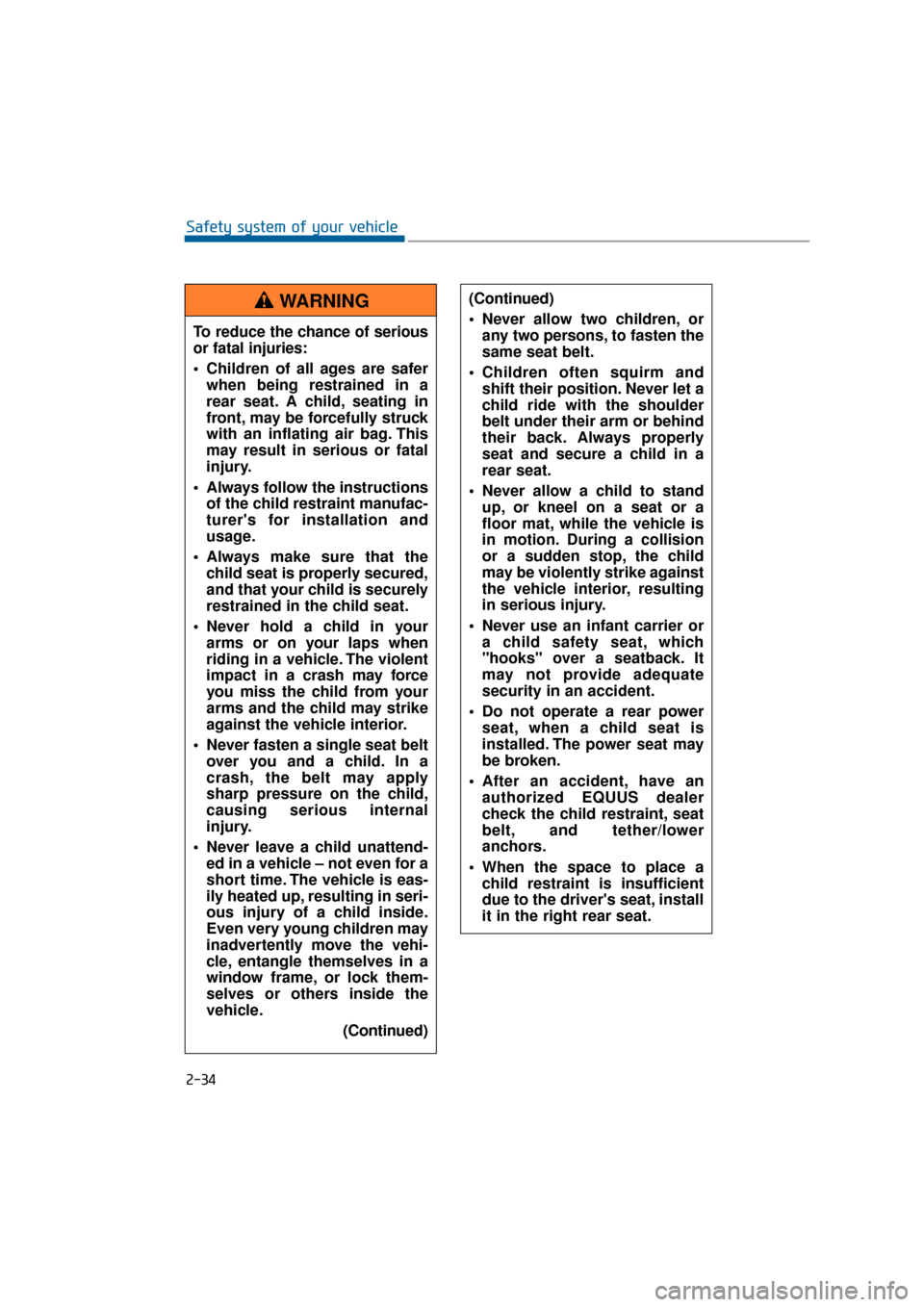
2-34
Safety system of your vehicleTo reduce the chance of serious
or fatal injuries:
Children of all ages are safer when being restrained in a
rear seat. A child, seating in
front, may be forcefully struck
with an inflating air bag. This
may result in serious or fatal
injury.
Always follow the instructions of the child restraint manufac-
turer's for installation and
usage.
Always make sure that the child seat is properly secured,
and that your child is securely
restrained in the child seat.
Never hold a child in your arms or on your laps when
riding in a vehicle. The violent
impact in a crash may force
you miss the child from your
arms and the child may strike
against the vehicle interior.
Never fasten a single seat belt over you and a child. In a
crash, the belt may apply
sharp pressure on the child,
causing serious internal
injury.
Never leave a child unattend- ed in a vehicle – not even for a
short time. The vehicle is eas-
ily heated up, resulting in seri-
ous injury of a child inside.
Even very young children may
inadvertently move the vehi-
cle, entangle themselves in a
window frame, or lock them-
selves or others inside the
vehicle.
(Continued)
(Continued)
Never allow two children, orany two persons, to fasten the
same seat belt.
Children often squirm and shift their position. Never let a
child ride with the shoulder
belt under their arm or behind
their back. Always properly
seat and secure a child in a
rear seat.
Never allow a child to stand up, or kneel on a seat or a
floor mat, while the vehicle is
in motion. During a collision
or a sudden stop, the child
may be violently strike against
the vehicle interior, resulting
in serious injury.
Never use an infant carrier or a child safety seat, which
"hooks" over a seatback. It
may not provide adequate
security in an accident.
Do not operate a rear power seat, when a child seat is
installed. The power seat may
be broken.
After an accident, have an authorized EQUUS dealer
check the child restraint, seat
belt, and tether/lower
anchors.
When the space to place a child restraint is insufficient
due to the driver's seat, install
it in the right rear seat.WARNING
Page 63 of 477
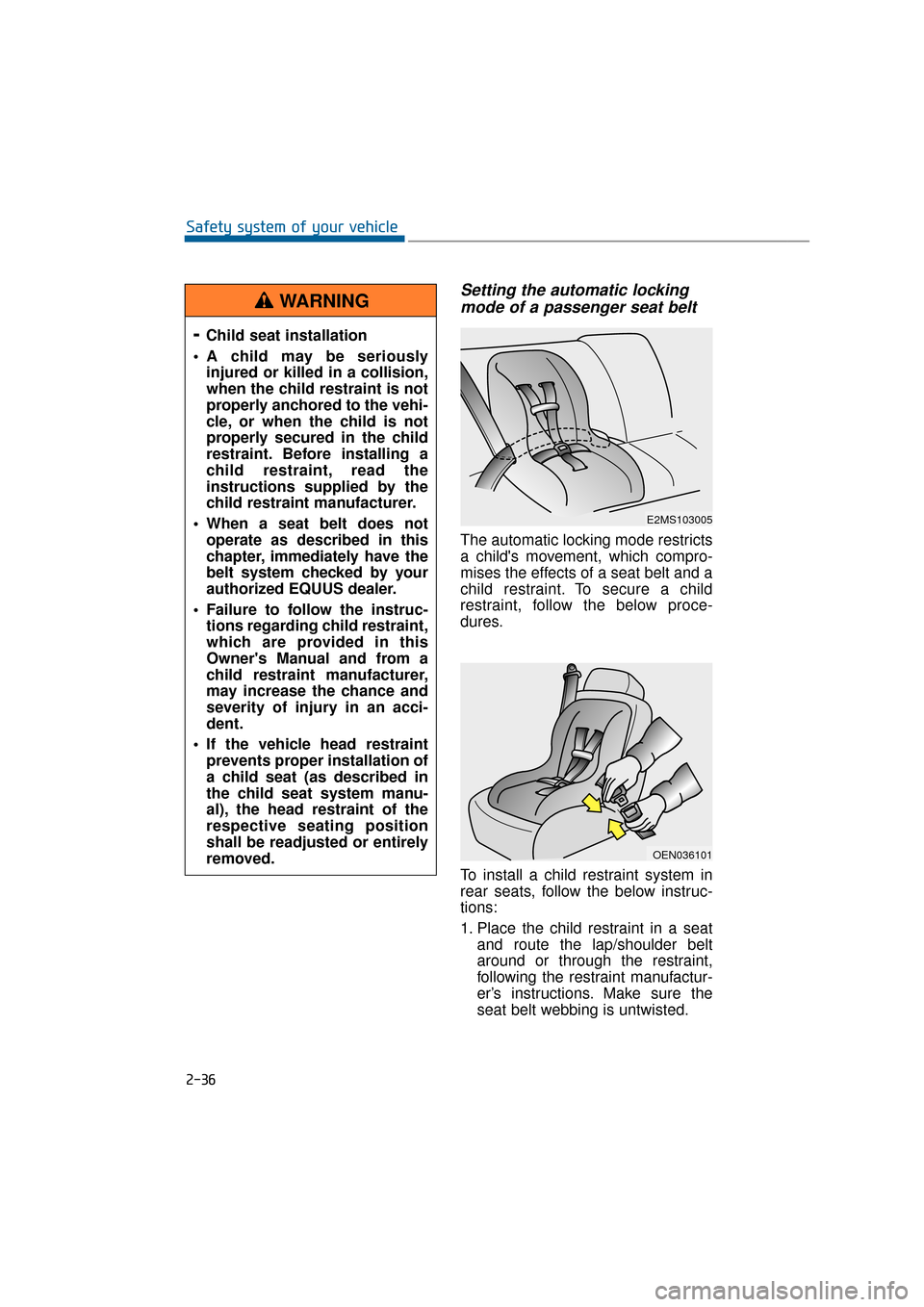
Setting the automatic lockingmode of a passenger seat belt
The automatic locking mode restricts
a child's movement, which compro-
mises the effects of a seat belt and a
child restraint. To secure a child
restraint, follow the below proce-
dures.
To install a child restraint system in
rear seats, follow the below instruc-
tions:
1. Place the child restraint in a seat
and route the lap/shoulder belt
around or through the restraint,
following the restraint manufactur-
er’s instructions. Make sure the
seat belt webbing is untwisted.
2-36
Safety system of your vehicle
- Child seat installation
A child may be seriously injured or killed in a collision,
when the child restraint is not
properly anchored to the vehi-
cle, or when the child is not
properly secured in the child
restraint. Before installing a
child restraint, read the
instructions supplied by the
child restraint manufacturer.
When a seat belt does not operate as described in this
chapter, immediately have the
belt system checked by your
authorized EQUUS dealer.
Failure to follow the instruc- tions regarding child restraint,
which are provided in this
Owner's Manual and from a
child restraint manufacturer,
may increase the chance and
severity of injury in an acci-
dent.
If the vehicle head restraint prevents proper installation of
a child seat (as described in
the child seat system manu-
al), the head restraint of the
respective seating position
shall be readjusted or entirely
removed.
WARNING
E2MS103005
OEN036101
Page 64 of 477
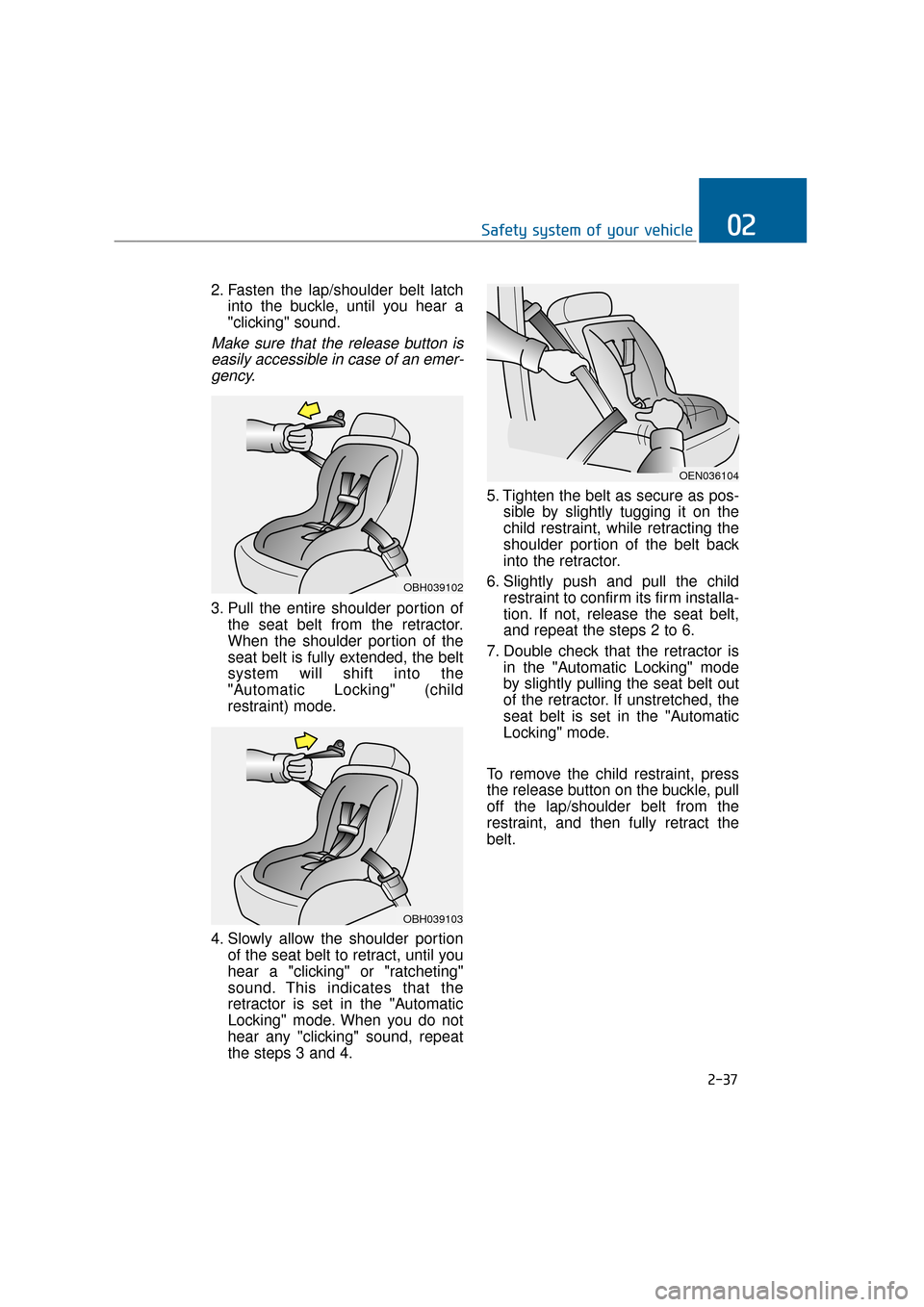
2. Fasten the lap/shoulder belt latchinto the buckle, until you hear a
"clicking" sound.
Make sure that the release button iseasily accessible in case of an emer-gency.
3. Pull the entire shoulder portion of the seat belt from the retractor.
When the shoulder portion of the
seat belt is fully extended, the belt
system will shift into the
"Automatic Locking" (child
restraint) mode.
4. Slowly allow the shoulder portion of the seat belt to retract, until you
hear a "clicking" or "ratcheting"
sound. This indicates that the
retractor is set in the "Automatic
Locking" mode. When you do not
hear any "clicking" sound, repeat
the steps 3 and 4. 5. Tighten the belt as secure as pos-
sible by slightly tugging it on the
child restraint, while retracting the
shoulder portion of the belt back
into the retractor.
6. Slightly push and pull the child restraint to confirm its firm installa-
tion. If not, release the seat belt,
and repeat the steps 2 to 6.
7. Double check that the retractor is in the "Automatic Locking" mode
by slightly pulling the seat belt out
of the retractor. If unstretched, the
seat belt is set in the "Automatic
Locking" mode.
To remove the child restraint, press
the release button on the buckle, pull
off the lap/shoulder belt from the
restraint, and then fully retract the
belt.
2-37
Safety system of your vehicle02
OBH039102
OBH039103
OEN036104
Page 65 of 477
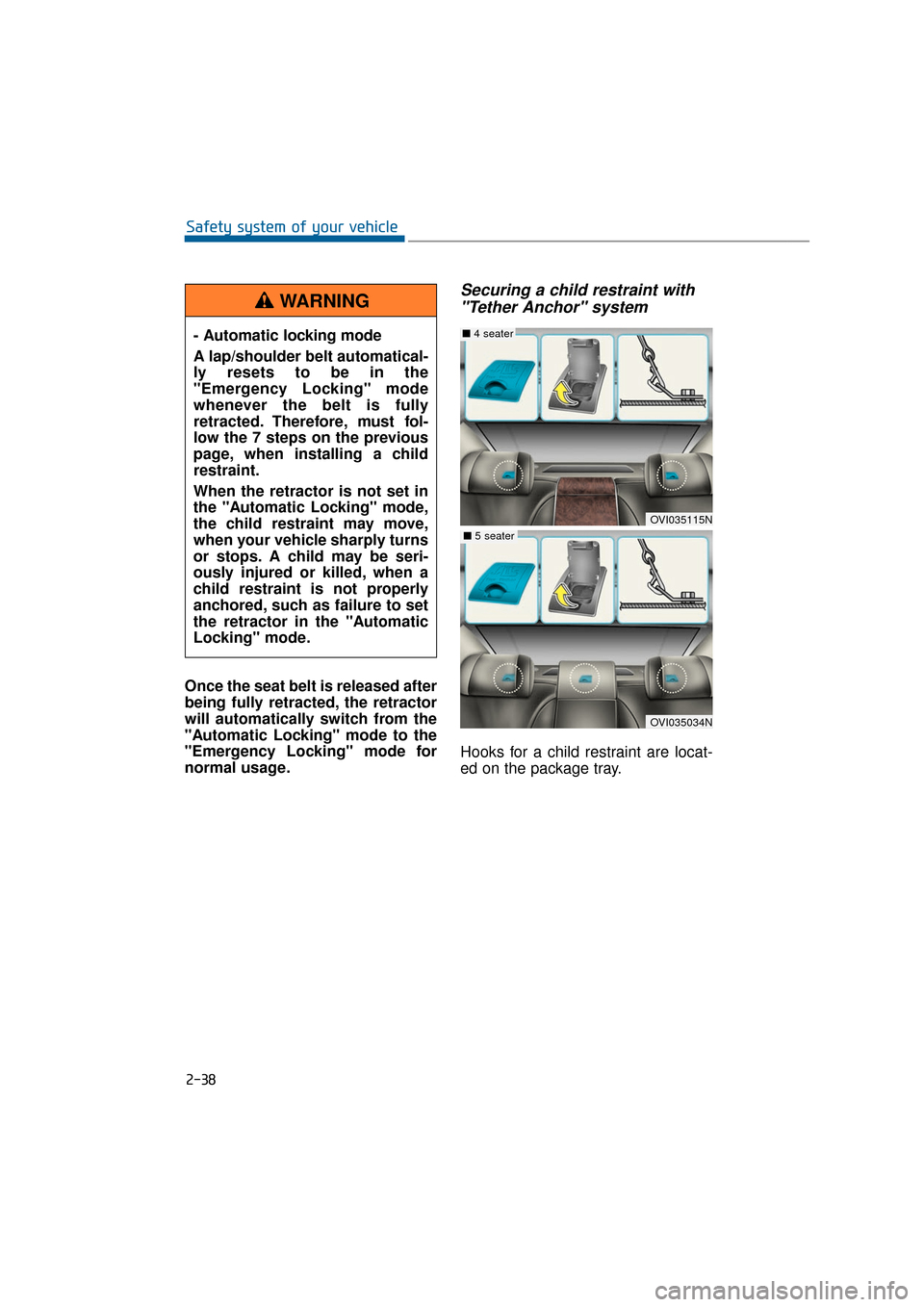
Once the seat belt is released after
being fully retracted, the retractor
will automatically switch from the
"Automatic Locking" mode to the
"Emergency Locking" mode for
normal usage.
Securing a child restraint with"Tether Anchor" system
Hooks for a child restraint are locat-
ed on the package tray.
2-38
Safety system of your vehicle
OVI035115N
■ 4 seater
OVI035034N
■ 5 seater
- Automatic loc king mode
A lap/shoulder belt automatical-
ly resets to be in the
"Emergency Locking" mode
whenever the belt is fully
retracted. Therefore, must fol-
low the 7 steps on the previous
page, when installing a child
restraint.
When the retractor is not set in
the "Automatic Locking" mode,
the child restraint may move,
when your vehicle sharply turns
or stops. A child may be seri-
ously injured or killed, when a
child restraint is not properly
anchored, such as failure to set
the retractor in the "Automatic
Locking" mode.
WARNING